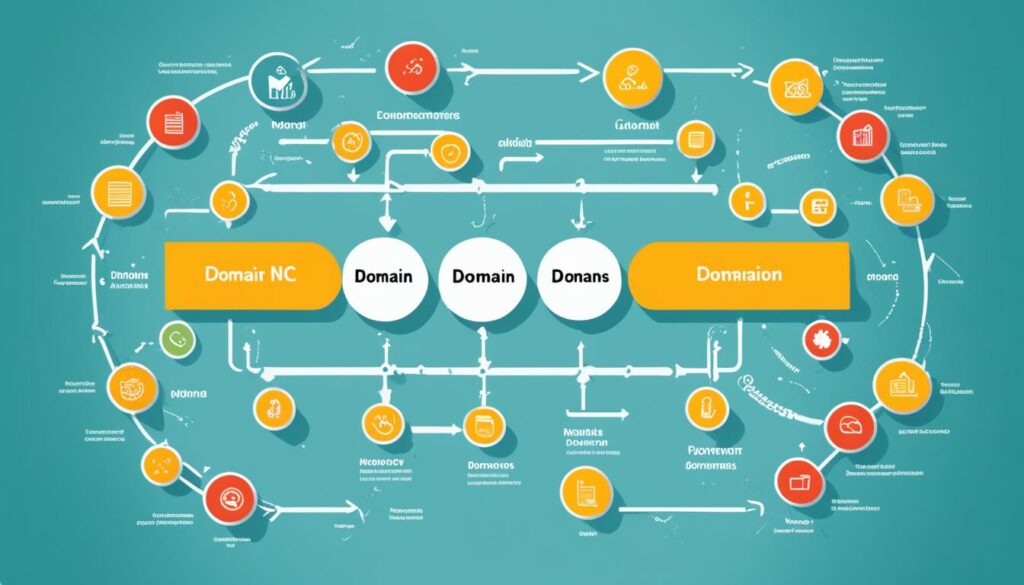Managing a lot of domain names is key for big international companies. This means planning how to buy, secure, manage, and enforce domains. This protects the company’s brand, improves online stuff, and makes managing domains easier.

We’re going to look at how a domain name travels through a company. We’ll give tips on handling them well. It’s tricky because rules for domain names keep changing. Plus, different groups around the world are involved.
Key Takeaways:
- Domain name portfolio management is crucial for organizations with international operations and a large number of domain names.
- Effective domain portfolio management involves strategic acquisition, security, management, and enforcement of domain names.
- Optimizing domain portfolios helps protect brand identity, streamline assets, and optimize online presence.
- Proactive domain name management is essential due to frequent changes in domain name regulations.
- Implementing best practices for domain portfolio management ensures efficient management of multiple domains.
Why Every Organization Requires Domain Portfolio Management
Being online is key for business success today. Organizations need good domain portfolio management to handle their domain names and guard their brand. This way, they can make the most of their online assets and keep a strong online presence.
For big international organizations with many domain names, managing them well is crucial. It streamlines their domain assets for better management and use. Doing this helps avoid spending too much on domains they don’t need and keeps their domain names in order.
Domain portfolio management also helps protect brands. It lets organizations keep an eye on and manage their domain names. This stops others from using their domain names without permission and fights off cybersquatting and brand theft.
Moreover, domain management services can offer insights and help with domain regulations and registrations. These services help get good domain names, ensure rules are followed, and maximize domain portfolio value.
Benefits of Domain Portfolio Management
Managing domain portfolios well brings many benefits to an organization:
- Enhanced brand protection: Active management keeps the brand safe and stops misuse of domain names.
- Optimized domain utilization: Effective management streamlines assets, boosts efficiency, and cuts unnecessary costs.
- Increased online visibility: Good management helps maintain a strong online presence, reaching more people.
- Improved security measures: Strong security, like domain locking and monitoring, protects domains from threats.
- Expert guidance: Domain services offer specialized help with regulations and registrations.
In conclusion, domain portfolio management is essential for any organization. It lets them handle domain names well, optimize online assets, protect their brand, and improve online visibility. By using domain management services and following best practices, organizations can manage their domains well and strengthen their online presence.
Domain Name Types
In our digital world, understanding different domain names is essential. This knowledge helps in building a strong domain management strategy. Let’s explore the types of domain names available:
Generic Top Level Domains (gTLDs)
Generic top-level domains, or gTLDs, include widely recognized extensions like .com, .org, and .net. gTLDs are not specific to any region, making them ideal for worldwide use. They fit global operations well and often get chosen by businesses seeking an international presence.
Country Code Top Level Domains (ccTLDs)
Country code top-level domains, ccTLDs, are linked to particular countries. For example, .us is for the United States, .uk for the United Kingdom, and .ca for Canada. ccTLDs give businesses a local online identity, building trust with local customers. Companies often use ccTLDs when entering new markets, targeting specific areas effectively.
Internationalized Domain Names (IDNs)
Internationalized domain names, or IDNs, support non-ASCII characters for registration. This lets businesses use local languages and characters for their domain names. For instance, a Chinese company can have a domain in Chinese characters. IDNs help global organizations reach and engage with diverse audiences around the world.
Comprehending the distinct domain types is key for effective domain portfolio management. From the worldwide appeal of gTLDs, the localized touch of ccTLDs, to the inclusivity of IDNs, each has special benefits.

With these insights, companies can better manage and optimize their domain portfolios. Next, we’ll look at how to manage a domain’s lifecycle within an organization.
Managing the Domain Name Lifecycle
The domain name lifecycle has four key parts: acquisition, security, management, and enforcement. Each part is crucial for managing and protecting domain names. Knowing and using best practices at each stage helps organizations protect their brand and do well online.
1. Domain Name Acquisition
The first step is getting new domain names or adding to an existing portfolio. It’s important to have a strategy that helps your brand and thinks about future needs. This might mean registering new domains early, buying pre-owned ones, or going to domain auctions for important assets.
2. Domain Name Security
Keeping domain names safe is key to stopping unauthorized access and hijacking. Use strong security steps like two-factor authentication, strong passwords, and keep an eye out for unauthorized changes. Locking domains and using registry security can also help protect them.
3. Domain Portfolio Management
Managing a lot of domain names well is important. Use a centralized system to keep track of when domains expire, manage DNS settings, and see how each domain is used. Streamlining these processes helps you use your domains better, follow rules, and work more efficiently.
4. Domain Enforcement
Domain enforcement means taking steps to protect trademarks and your brand’s reputation. Watch for problems like cybersquatting and take action when needed. You might need to use legal routes, like ICANN’s policies, to protect your domains and brand.
Managing each stage of the domain lifecycle well is vital for a strong online presence and brand protection. Using smart strategies for acquisition, security, management, and enforcement helps navigate the domain world and get the most from your domains.

Portfolio Acquisition
Building a great domain name portfolio needs a solid plan. This plan should match your business’s brand goals. It’s key to think ahead about your domain needs. Look into getting domains that already exist to make your portfolio better. When you plan well, taking into account brand, location, and language, your online presence gets stronger.
It’s crucial to have a domain name strategy. This means setting clear goals for your domains and lining them up with your business’s main aims. A well-thought-out strategy helps make good choices. It ensures the domains you get improve your brand’s visibility and trust.
For acquisition, find and secure the right domains for your brand and audience. This might mean getting new domains, picking up expired ones, or talking to current owners. Knowing your market well helps you find valuable domains to enhance your collection.
Being smart about domain allocation helps avoid overspending and adds value to your portfolio. Look closely at what domains you really need for your business goals. Get the most important domains for your brand’s visibility first. This way, your spending is focused and you don’t waste money.
Getting pre-owned domains can be a good move. These domains often have traffic and rank higher in searches because they’re established. But, when buying these domains, it’s critical to check they fit your brand and don’t have any search engine penalties.
When picking domains, think about brand, location, and language. Your domains should match where you want to be seen and who you want to reach. Looking at what domains your competitors use and current trends can also help a lot.

The table below provides a comprehensive comparison of different domain acquisition strategies:
| Strategy | Pros | Cons |
|---|---|---|
| Registering new domain names | – Allows you to secure brand-specific domain names – Provides flexibility in choosing relevant domain extensions |
– Requires ongoing registration fees – Limited availability of desired domain names |
| Acquiring expired domains | – Provides access to domains with existing backlinks and authority – May already have established traffic |
– Requires careful research to avoid any penalties from search engines – Not all expired domains are valuable |
| Negotiating with domain owners | – Allows you to acquire premium domains with high-value keywords – Can provide opportunities for domain name partnerships |
– May require significant financial investment – Negotiations can be time-consuming |
By thinking carefully about your strategy and including pre-owned domains, you can create a strong domain portfolio. This will boost your brand’s online look and support your business goals.
Portfolio Security
Keeping your domain name secure is vital to protect your organization from threats like domain hijacking, cybersquatting, and typosquatting. Strong security practices are crucial. They keep your digital assets safe, maintaining your brand’s integrity and reputation.
The Importance of Domain Name Security
When unauthorized persons take over your domain, it’s called domain hijacking. This can result in losing control over your website, disrupting business, and harming your brand. Cybersquatting and typosquatting can also damage your brand by confusing customers or leading them to harmful sites.
“Domain name security measures are crucial for protecting your organization’s online presence and preserving your brand reputation.”
Implementing Strong Security Measures
To safeguard your domain names, strong security measures are a must:
- Use strong, unique passwords for all domain name accounts, including domain registrars and DNS providers.
- Enable two-factor authentication (2FA) for an added security layer on your domain accounts.
- Think about domain locking to stop unauthorized transfers of your domain names.
- Keep a close watch on your domains for any unauthorized changes, like DNS hijacking or domain setting alterations.
Securing Valuable Domains at the Registry Level
Securing your important domains at the registry level offers extra protection. This means working closely with domain registries to add more security controls.

Collaborating with registries helps shield your domain names from hijacking and illegal acts. Joining programs like the Domain Name System Security Extensions (DNSSEC) helps verify your domain’s DNS records are authentic.
Portfolio Monitoring and Enforcement
Keeping a close eye on your domain portfolio is key. This helps avoid issues such as cybersquatting and typosquatting. Taking quick action is vital to maintain your brand’s integrity online.
For strong portfolio monitoring, various strategies work well. These include running regular scans and using sophisticated tools. These efforts spot infringements or unauthorized domain registrations early.
Implementing Domain Monitoring Systems
Domain monitoring systems are crucial. They detect threats to your brand’s online presence around the clock. These systems look for domain registrations that could be stepping on your trademarks.
Technologies that monitor WHOIS databases in real time are also beneficial. They help notice fishy domain registrations or ownership changes fast. That way, an organization can act quickly to defend its domain assets.
Enforcement Measures
When you find a domain that infringes on your rights, you have options. The Uniform Domain-Name Dispute-Resolution Policy (UDRP) by ICANN offers a simple way to handle disputes without court. A UDRP complaint could lead to the infringing domains being transferred or canceled.
For clear cases of trademark infringement, the Uniform Rapid Suspension System (URS) is quick and less costly. It’s faster than going to court, saving both time and money. This helps protect rights more efficiently.
In some situations, going to court may be the only option. It’s wise to talk with a lawyer who knows about domain enforcement. They can help decide the best step forward.
Watching over your domain portfolio and enforcing your rights is vital for your brand. Doing this well prevents harm from cybersquatting and typosquatting. By staying vigilant and responsive, companies can keep their online presence safe.
| Key Actions | Benefits |
|---|---|
| Implement advanced domain monitoring tools | Early detection of potential infringements |
| Regularly conduct comprehensive scans of domain registrations | Identify unauthorized registrations and potential threats |
| Utilize real-time WHOIS database monitoring | Promptly detect changes in domain ownership |
| File a UDRP complaint | Seek transfer or cancellation of infringing domains |
| Utilize the URS for clear-cut cases of infringement | Swift and cost-effective resolution of disputes |
| Consider legal action if necessary | Ensure comprehensive protection of domain assets |

Building a Defensive Domain Registration Strategy
Keeping your brand safe online is now more important than ever. A defensive domain registration strategy is vital. It helps protect brand names and stops unauthorized sign-ups. By securing important domains, companies keep their online image safe and lower the risk of their brand being misused.
To build a strong defense, companies can use several strategies.
1. Registering domains in new gTLDs through the Trademark Clearinghouse
Using the Trademark Clearinghouse enhances defensive domain registration. It’s a central list of checked trademarks. Registering domains related to your brand in new gTLDs through the Trademark Clearinghouse improves your legal standing. It also keeps your brand safe from infringement.
2. Using blocking services to prevent unauthorized registrations
Blocking services add a layer of safety by stopping others from registering domain names similar to your brand. They use smart algorithms to find domains that might infringe on your trademark. Then, they prevent their registration. This lowers the risk of cybersquatting and typosquatting.
3. Registering ccTLDs to safeguard brand names
Country code top-level domains (ccTLDs) are key for creating a local online presence and protecting your brand in specific areas. Registering relevant ccTLDs makes sure your brand stays secure. It also remains well-known to local customers.
4. Brand monitoring to detect and dispute infringing registrations
Brand monitoring is essential for spotting possible threats to your brand. It helps find unauthorized domain registrations and squatting. Using brand monitoring tools, companies can quickly spot and dispute unapproved uses. This protects your company’s good name and customer trust.
To keep your brand safe, you need to stay proactive and keep an eye on things. With the Trademark Clearinghouse, blocking services, ccTLD registrations, and brand monitoring, your online presence will be stronger. This helps keep your brand identity safe.
It’s crucial to remember that defensive domain registration is a continuous effort. It needs regular checks and updates to keep up with new threats. So, always be ready to adjust your strategy to fight off these challenges.
Building a Promotional Domain Registration Strategy
A promotional domain registration strategy helps grow a company’s online presence and boost its marketing. By smartly choosing domains and using different methods, companies can target specific audiences to promote their goods or services. We’ll look into strategies like driving traffic, targeting various market segments, and supporting marketing drives for better promotion.

Driving Traffic through Domain Registration
Registering related domains is a smart move to bring traffic to your main site. Pick domain names that reflect your main brand or key ideas to attract potential clients. These domains guide people to your main site, boosting visits and leading to more customer interest and sales.
Multiple Vertical Domains for Enhanced Reach
In the fierce business world, hitting the right market segments is key. Register domains tailored to different niches or target markets. This method ensures you connect well with specific groups, improving the chance of pulling in quality leads and broadening your market scope.
Utilizing Microsites for Marketing Campaigns
Marketing efforts often need a unique online space to share their message and connect with the audience. Creating microsites for these campaigns through domain registration allows for a focused approach. Such sites can offer relevant content, interactive features, and clear actions for users, amplifying the campaign’s effects and achieving goals.
“A promotional domain registration strategy grabs your target market’s attention, making you shine in a crowded field. Choosing and using domain names wisely can lift your digital marketing and lead more visitors to your main site.” – Marketing Expert
With a smart promotional domain registration plan, companies can grow their web presence, target the right traffic, and highlight their products or services. Techniques like traffic redirection, focusing on various industries, and creating campaign-specific domains boost marketing and increase brand recognition.
| Benefits of Promotional Domain Registration | Examples |
|---|---|
| Enhances online visibility and reach | www.winterfashion.com |
| Targets specific verticals for better engagement | www.coffeebeanspecialist.com |
| Drives traffic and conversions to main website | www.deals-for-everyone.com |
| Supports focused marketing campaigns | www.summersale2021.com |
Domain Management Software
Managing domains can be tricky, but the right tools make it easier. We’ll look at tools and services that help manage domains effectively. This includes domain registrars and hosting services.
Domain Registrars
Domain registrars help you register and manage domain names. They make acquiring and maintaining domains simple. Here are some top choices:
- GoDaddy
- Namecheap
- Google Domains
- Hover
These registrars are known for their easy use, good prices, and strong support.
Hosting Services
After registering domains, you need hosting to manage website content. Hosting provides the tech to store your files and show your site online. Well-known providers include:
- Bluehost
- SiteGround
- HostGator
- DreamHost
They offer different plans and features, fitting various needs. They ensure your site runs well and stays secure.
Portfolio Management Tools
For managing many domains, portfolio tools are key. They help keep track of expiration dates and monitor for security issues. Some top tools are:
- NameSilo
- DomainTools
- Efty
- DomainIQ
These tools help organize your domains, keeping them secure and updated.

Using the right tools and services makes domain management easier and more efficient. These resources help you manage domains well, ensuring your online presence runs smoothly.
| Domain Management Software | Key Features |
|---|---|
| NameSilo | Domain portfolio organization, bulk domain management, DNS management |
| DomainTools | Domain monitoring, historical domain data, WHOIS lookup |
| Efty | Domain sales and negotiation platform, mobile app, reporting and analytics |
| DomainIQ | Domain name research, WHOIS history, domain valuation |
Conclusion
Managing your domain portfolio well is key for protecting your brand and getting the most out of your online assets. This article shared insights on how to pick domain names, keep them safe, handle them well, and enforce your rights. By using domain management tools, businesses can boost the value of their domains and manage their web presence better.
To do well in domain portfolio management, you need to plan ahead. Consider your brand identity, where you operate, and the languages you use. Adopting a proactive approach is vital.
Keep in mind, keeping your domain portfolio secure and well-managed is an ongoing effort. It requires constant watch, taking action when needed, and making changes as things online change. Be alert to avoid losing control of your valuable domains.